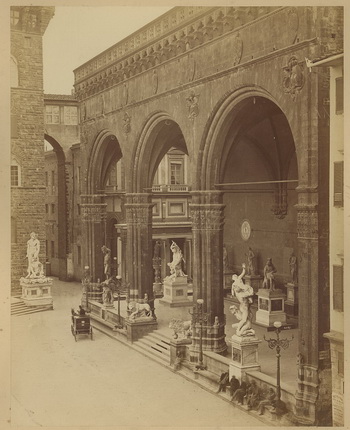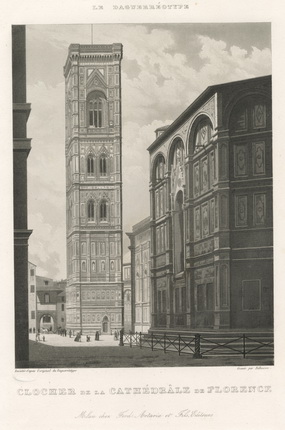Grand Tour: Russian version. Florence
Pavel and Anastasia Khoroshilov’s collection








Fratelli Alinari. Loggia dei Lanzi. Piazza della Signoria. Florence. 1870s
Engraver Falheisen. Giotto’s Campanile. The series ‘Views of Florence’. Aquatint. Engraving daguerreotype. 1840s
Fratelli Alinari. The series ‘Giglio’. Florence. 1870s
Fratelli Alinari. David by Michelangelo. Galleria dell'Accademia. Florence. 1860s
Fratelli Alinari. Group portrait by a well in the large cloister in the Certosa del Galluzzo. Florence. 1875-1880
Edizioni Brogi. Torre Pendente di Pisa. Pisa. 1860s
Triumphal Arch of the Lorraine. Florence. Engraving by Johann Jakob Falkeisen from the daguerreotype. 1840 – 1845. The album ‘Recueil de vues principales de la Toscane’
Fratelli Alinari. Ponte Vecchio. Florence. 1855
Moscow, 28.06.2016—11.09.2016
exhibition is over
Share with friends
Curator: Anastasia Korotkova
For the press
Florence is the birthplace of the Renaissance and the capital of Tuscany, an open-air city-museum with unique architecture and many places of interest. Benvenuto Cellini, Giotto di Bondone, Raphael Santi, Pietro Perugino, Piero della Francesca, Donatello, Michelangelo Buonarroti and Leonardo da Vinci all worked here and made an immeasurable contribution to the development of Italian and world culture. The Florentine Dante Alighieri laid the foundations of a national literary Italian language with his great epic poem ‘The Divine Comedy’. Giotto’s well-known portrait of Dante hangs in the chapel at the Bargello Palace.
Due to its history the ‘city on the banks of the Arno’ became an obligatory stopping point on the route of the European Grand Tour. With good reason the final exhibition of the ‘Grand Tour: Russian Version’ project invites visitors who have already taken a photographic journey through Rome, Naples and Venice to set off again, this time on a trip to Florence and Tuscany.
Many illustrious Russian writers, artists and public figures of the 19th century left reminiscences of their sojourns in the ‘city of flowers’. Fyodor Dostoevsky wrote the greater part of his novel ‘The Idiot’ there, while Pyotr Tchaikovsky loved to visit Florence, considering it an excellent source of inspiration. In 1871 a monument was erected in honour of the Russian industrialist Nikolai Demidov, on a square named Piazza Demidoff in the very centre of town. Demidov Senior established an almshouse for orphans and the elderly in Florence, as well as donating considerable sums of money to the construction and restoration of churches. The façade of the famous Cathedral of Santa Maria del Fiore is decorated with the Demidov family crest.
In the 1850s the Tuscan capital became an important photographic centre in Italy. Landscape and architectural images were in great demand from travellers keen to buy pictures of Renaissance monuments as a souvenir. The early history of photography in Florence is connected, above all, to two family businesses, those of Alinari and Brogi. Both companies produced views and architectural photographs of Italy. Giacomo Brogi was made famous by his images of tourist destinations in Tuscan towns. His shots are distinguished by their compositional austerity and laconicism, as well as the attention paid to architectural detail.
The name Alinari is associated with the heyday of Florentine photography. As a result of the brothers’ entrepreneurial activity and their contracts with major museums the firm soon gained international recognition. By 1856 they had published a catalogue with views of Florence, Siena and Pisa. Moreover the Alinaris played an important role in the propagation of photographic reproductions showing Italian works of art. These images were highly commended by eminent art critics of the period, including John Ruskin.
Alphonse Bernoud from France and Giovanni Brampton Philpot from England were also working in Florence, at the same time as Alinari and Brogi. Paolo Lombardi, Giulio Rossi, Celestino Degoix and the Milanese photographer Luigi Sacchi captured the sights in Pisa, Siena and Genoa.
‘Voyages Pittoresques’, a series of engravings created from daguerreotypes and devoted to the architectural monuments of Europe, enjoyed great popularity in the mid-19th century. The exhibition opens with aquatints from the album ‘Recueil de Vues Principales de la Toscane’ (Collected Views of Tuscany), published in Milan from 1840 to 1845. These engravings were made from the first Italian daguerreotype series with views of Florence, Pisa and Livorno.
The photographs presented in this exhibition were brought home by Russian travellers who visited Florence in the second half of the 19th century. Thanks to them we have the opportunity to see remarkable images taken by the first Florentine photographers.
Corporate trustee
General radio partners |
Strategic information partners |
Special media partner
Information partners





